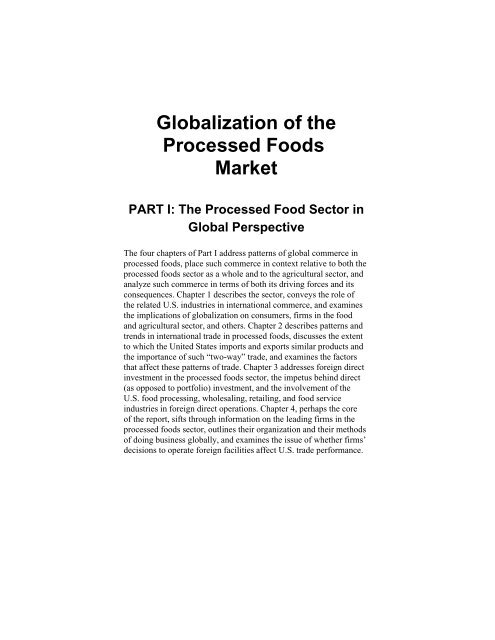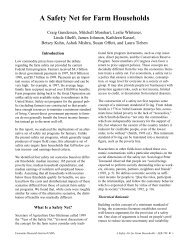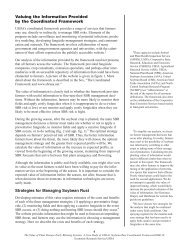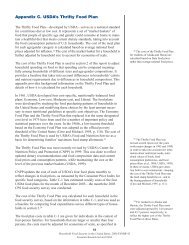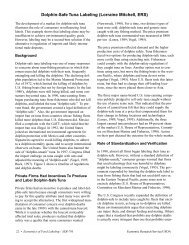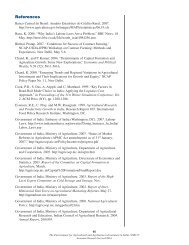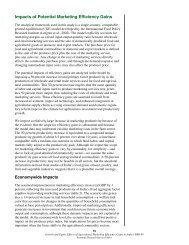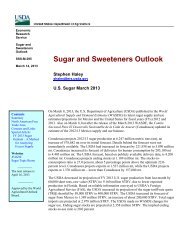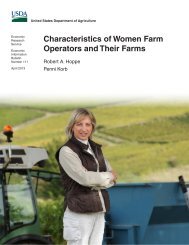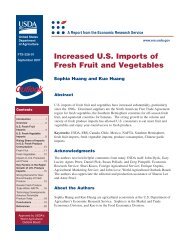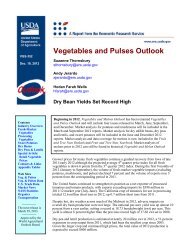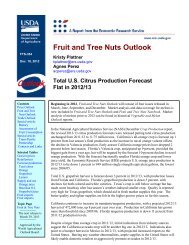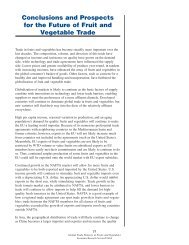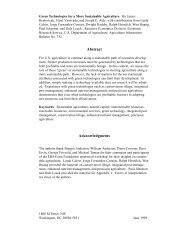Globalization of the Processed Foods Market - Economic Research ...
Globalization of the Processed Foods Market - Economic Research ...
Globalization of the Processed Foods Market - Economic Research ...
Create successful ePaper yourself
Turn your PDF publications into a flip-book with our unique Google optimized e-Paper software.
<strong>Globalization</strong> <strong>of</strong> <strong>the</strong><br />
<strong>Processed</strong> <strong>Foods</strong><br />
<strong>Market</strong><br />
PART I: The <strong>Processed</strong> Food Sector in<br />
Global Perspective<br />
The four chapters <strong>of</strong> Part I address patterns <strong>of</strong> global commerce in<br />
processed foods, place such commerce in context relative to both <strong>the</strong><br />
processed foods sector as a whole and to <strong>the</strong> agricultural sector, and<br />
analyze such commerce in terms <strong>of</strong> both its driving forces and its<br />
consequences. Chapter 1 describes <strong>the</strong> sector, conveys <strong>the</strong> role <strong>of</strong><br />
<strong>the</strong> related U.S. industries in international commerce, and examines<br />
<strong>the</strong> implications <strong>of</strong> globalization on consumers, firms in <strong>the</strong> food<br />
and agricultural sector, and o<strong>the</strong>rs. Chapter 2 describes patterns and<br />
trends in international trade in processed foods, discusses <strong>the</strong> extent<br />
to which <strong>the</strong> United States imports and exports similar products and<br />
<strong>the</strong> importance <strong>of</strong> such “two-way” trade, and examines <strong>the</strong> factors<br />
that affect <strong>the</strong>se patterns <strong>of</strong> trade. Chapter 3 addresses foreign direct<br />
investment in <strong>the</strong> processed foods sector, <strong>the</strong> impetus behind direct<br />
(as opposed to portfolio) investment, and <strong>the</strong> involvement <strong>of</strong> <strong>the</strong><br />
U.S. food processing, wholesaling, retailing, and food service<br />
industries in foreign direct operations. Chapter 4, perhaps <strong>the</strong> core<br />
<strong>of</strong> <strong>the</strong> report, sifts through information on <strong>the</strong> leading firms in <strong>the</strong><br />
processed foods sector, outlines <strong>the</strong>ir organization and <strong>the</strong>ir methods<br />
<strong>of</strong> doing business globally, and examines <strong>the</strong> issue <strong>of</strong> whe<strong>the</strong>r firms’<br />
decisions to operate foreign facilities affect U.S. trade performance.
Definitions and Clarifications<br />
As with any classification scheme, <strong>the</strong>re are multiple ways <strong>of</strong><br />
deciding what is or is not a processed food product. This report<br />
adopts <strong>the</strong> definition <strong>of</strong> “Food and Kindred Products” in <strong>the</strong><br />
Standard Industrial Classification (SIC) system developed by <strong>the</strong><br />
U.S. Department <strong>of</strong> Commerce. The SIC is <strong>the</strong> statistical<br />
classification underlying all establishment-based U.S. economic<br />
statistics that are classified by type <strong>of</strong> industry (OMB, 1987). It<br />
assigns establishments to industry groups based on <strong>the</strong>ir principal<br />
economic activity. Under <strong>the</strong> SIC system, establishments or plants<br />
that produce similar products, use similar processes, or provide<br />
similar services are assigned <strong>the</strong> same two-digit code number. The<br />
49 industries in <strong>the</strong> processed foods sector are known as “Food and<br />
Kindred Products” and fall into group SIC-20, as listed in table 1. 1<br />
SIC-20 includes establishments that manufacture or process foods<br />
and beverages for human consumption, as well as certain related<br />
products, such as chewing gum, fats and oils, and animal feeds.<br />
SIC-20 includes only foods, not agricultural products in general.<br />
Thus, tobacco products and textiles are not included in SIC-20,<br />
even though <strong>the</strong>y are derived from agricultural operations.<br />
Similarly, <strong>the</strong> processed foods industries include fresh meat<br />
products and processed seafood, but not fresh fruits and vegetables.<br />
However, <strong>the</strong> processed foods category does include some products<br />
that are excluded when <strong>the</strong> Department <strong>of</strong> Commerce calculates<br />
output from <strong>the</strong> agricultural sector. Prominent among <strong>the</strong>se<br />
products are: aquaculture output, such as frozen fish and canned<br />
1 Three o<strong>the</strong>r industries are closely connected to food processing: food wholesaling<br />
(a portion <strong>of</strong> SIC-51), food retailing (SIC-54), and food service (SIC-58). Food<br />
wholesaling and food retailing toge<strong>the</strong>r constitute <strong>the</strong> food distribution system, our<br />
food-at-home marketing network. Wholesale and retail firms work to ensure that a<br />
ready supply <strong>of</strong> a large variety <strong>of</strong> food products is available on demand to<br />
consuming households. Major functions <strong>of</strong> this network include food product<br />
assembly and distribution, product transportation, and storage and preservation. The<br />
food service industry constitutes <strong>the</strong> “away-from-home” food consumption market.<br />
This industry is dominated by restaurants and fast-food outlets, but also includes<br />
o<strong>the</strong>r commercial establishments, plus food service in establishments that cater to<br />
in-house residents, such as nursing homes and educational institutions.<br />
2 <strong>Globalization</strong> <strong>of</strong> <strong>the</strong> <strong>Processed</strong> <strong>Foods</strong> <strong>Market</strong>
tuna; tree produce, such as ground c<strong>of</strong>fee and shelled nuts; and<br />
alcoholic beverages, since <strong>the</strong>y are derived from grains and fruits.<br />
Products in SIC-20 must be value-added products, which do not<br />
always correspond to <strong>the</strong> more problematical “high-value products”<br />
designation. Fresh fruits, seafood items, and unshelled nuts are<br />
examples <strong>of</strong> high-value products that have undergone no processing,<br />
and hence are excluded from SIC-20. Conversely, some<br />
“low-value” products are included in SIC-20, such as animal feeds<br />
and manufactured ice, because some processing had to take place to<br />
get <strong>the</strong> product to <strong>the</strong> customer. A final clarification was alluded to<br />
earlier, <strong>the</strong> distinction between intermediate goods and final goods.<br />
Many processed food products serve as inputs into o<strong>the</strong>r<br />
manufactured foods and o<strong>the</strong>r goods, particularly those in <strong>the</strong> dairy<br />
products, grain mill products, and fats and oils categories. All <strong>of</strong><br />
<strong>the</strong>se items are included in SIC-20, whe<strong>the</strong>r <strong>the</strong> final destination is<br />
use as an intermediate product or consumption as a final good. In<br />
addition, many products are sold at a number <strong>of</strong> value-added levels.<br />
For example, beef sold “on ho<strong>of</strong>” is listed as a raw commodity.<br />
However, as beef moves fur<strong>the</strong>r down stream toward <strong>the</strong> consumer,<br />
it is always listed in <strong>the</strong> processed food category, whe<strong>the</strong>r it is sold<br />
as carcass beef (slaughter), as boxed beef (initial packaging), or as<br />
final cut (shrink-wrapped in <strong>the</strong> grocery display case).<br />
<strong>Globalization</strong> <strong>of</strong> <strong>the</strong> <strong>Processed</strong> <strong>Foods</strong> <strong>Market</strong> 3
Table 1—Standard Industrial Classification (SIC) codes for<br />
food and kindred products<br />
SIC Product description SIC Product description<br />
20 Food and kindred products 206 Sugar and confections<br />
201 Meat products 2061 Cane sugar, raw<br />
2011 Meat packing 2062 Cane sugar, refined<br />
2013 Sausage and prepared meats 2063 Beet sugar<br />
2015 Poultry dressing plants 2064<br />
Candy and confectionery<br />
products<br />
202 Dairy products 2066<br />
Chocolate and cocoa<br />
products<br />
2021 Creamery butter 2067 Chewing gum<br />
2022 Cheese, natural and processed 2068<br />
Salted and roasted nuts<br />
and seeds<br />
2023 Condensed and evaporated milk 207 Fats and oils<br />
2024 Ice cream and frozen desserts 2074 Cottonseed oil mills<br />
2026 Fluid milk 2075 Soybean oil mills<br />
2076 Vegetable oil mills<br />
203 Preserved fruit and vegetables 2077 Animal/marine fats and oils<br />
2032 Canned specialties 2079 Shortening and cooking oils<br />
2033 Canned fruit adn vegetables<br />
2034 Dried fruit and vegetables 208 Beverages<br />
2035 Sauces and salad dressings 2082 Malt beverages<br />
2037 Frozen fruit and vegetables 2083 Malt<br />
2038 Frozen specialties 2084<br />
Wines, brandy, and brandy<br />
spirits<br />
2085 Distilled and blended spirits<br />
204 Grain mill products 2086<br />
S<strong>of</strong>t drinks and carbonated<br />
water<br />
2041 Flour and grain mill products 2087<br />
Flavorings, extracts, and<br />
syrups<br />
2043 Breakfast cereals<br />
2044 Rice milling 209 Miscellaneous<br />
2045 Blended and prepared flours 2091 <strong>Processed</strong> fishery products<br />
2046 Wet corn milling 2092 Fresh fish<br />
2047 Dog, cat and o<strong>the</strong>r pet food 2095 Roasted c<strong>of</strong>fee<br />
2048 Prepared animal feed 2096 Potato chips<br />
2097 Manufactured ice<br />
205 Bakery products 2098 Pasta products<br />
2051 Bread and o<strong>the</strong>r 2099 O<strong>the</strong>r food preparation<br />
2052 Cookies and crackers<br />
2053<br />
Frozen bakery products, excl.<br />
bread<br />
4 <strong>Globalization</strong> <strong>of</strong> <strong>the</strong> <strong>Processed</strong> <strong>Foods</strong> <strong>Market</strong>
CHAPTER 1<br />
The U.S. Food Sector<br />
Food Processing and Distribution in <strong>the</strong> United<br />
States<br />
The food processing industries are <strong>the</strong> largest manufacturing sector<br />
in <strong>the</strong> U.S. economy, accounting for approximately 14 percent <strong>of</strong><br />
total U.S. manufacturing output (U.S. Department <strong>of</strong> Commerce<br />
1994). Food processing shipments have increased steadily in <strong>the</strong> last<br />
decade, from $330 billion in 1987 to $404 billion in 1992 and $430<br />
billion in 1994. 2 By contrast, on-farm cash marketing receipts from<br />
livestock and crops production totaled less than $200 billion<br />
(<strong>Economic</strong> Report <strong>of</strong> <strong>the</strong> President, 1995). In fact, <strong>the</strong> total<br />
value-added (revenues less cost <strong>of</strong> purchased materials and energy)<br />
<strong>of</strong> <strong>the</strong> three main industries in <strong>the</strong> food marketing system (food<br />
processing, food wholesaling and retailing, and food service) was<br />
$372 billion, over four times greater than <strong>the</strong> $84.6 billion<br />
contribution <strong>of</strong> farm output to gross domestic product.<br />
The number <strong>of</strong> food processing establishments declined from<br />
28,193 in 1972 to 20,583 by 1987. This decline seems to have<br />
halted, however. By 1992, <strong>the</strong> number <strong>of</strong> establishments had<br />
increased slightly, to 20,792. There has also been a slow longrun<br />
decline in <strong>the</strong> number <strong>of</strong> employees in <strong>the</strong> U.S. food processing<br />
industries—from 1.75 million in 1972 to 1.64 million in 1982. Since<br />
1982, <strong>the</strong> number <strong>of</strong> employees has remained virtually static, with<br />
only small year-to-year fluctuations.<br />
Trade in <strong>Processed</strong> <strong>Foods</strong> and Farm Commodities<br />
The processed foods sector is much larger than <strong>the</strong> farm sector not<br />
only in total value <strong>of</strong> production, but in international trade as well.<br />
2 In processed foods terminology, <strong>the</strong> term “shipments” refers, not to international<br />
transport, but to <strong>the</strong> domestic transport <strong>of</strong> processed foods from production plants<br />
to all destinations, including wholesalers, retailers, o<strong>the</strong>r plants, and export<br />
facilities.<br />
<strong>Globalization</strong> <strong>of</strong> <strong>the</strong> <strong>Processed</strong> <strong>Foods</strong> <strong>Market</strong> 5
Yet Dayton and Henderson (1992) point out that, compared with<br />
trade in commodities “. . . agricultural economists have given<br />
relatively little attention to international trade flows in processed<br />
foods” (p. 1).<br />
The generally accepted view <strong>of</strong> agricultural trade is told from a<br />
comparative advantage argument emphasizing abundant, fertile<br />
land and a favorable farm structure. In this model, national<br />
specialization results in <strong>the</strong> United States exporting corn and<br />
soybeans, while importing bananas and papayas. <strong>Processed</strong> foods<br />
are different. Technology, with highly differentiated foods branded<br />
and made convenient for consumers, adds many dimensions not<br />
captured by standard analysis <strong>of</strong> comparative advantage.<br />
Great distinctions can be made between raw agricultural products<br />
and processed foods at <strong>the</strong> producer level and at <strong>the</strong> consumer<br />
level. First, <strong>the</strong> distance to consumers is much less for processed<br />
foods manufacturers than for agricultural producers. The far<strong>the</strong>r<br />
along a product moves in time, space, and form away from <strong>the</strong><br />
farmer, <strong>the</strong> closer its connection to <strong>the</strong> consumer. Perhaps <strong>the</strong> most<br />
apparent result is branded products, which are not supplied by any<br />
but <strong>the</strong> most vertically integrated farmers. Grains fit <strong>the</strong><br />
comparative advantage model very well, grain mill products fairly<br />
well, meat products less well, and Big Macs not at all.<br />
The link between processed foods manufacturers and consumers is<br />
fed by <strong>the</strong> high incomes and individualistic nature <strong>of</strong> American<br />
society. These are reflected in <strong>the</strong> entrepreneurial nature <strong>of</strong> U.S.<br />
business and highly developed consumer preferences. Technology,<br />
information, communications, and research and development have<br />
all played a part in making <strong>the</strong> United States a leader in <strong>the</strong><br />
processed foods industries.<br />
The higher <strong>the</strong> level <strong>of</strong> processing, <strong>the</strong> higher <strong>the</strong> level <strong>of</strong> product<br />
differentiation, thanks to a very sophisticated marketing research<br />
capability in <strong>the</strong> United States. Manufacturers are able to discover<br />
what consumers want and deliver it with <strong>the</strong> product characteristics<br />
that consumers prefer. And <strong>the</strong> more differentiated <strong>the</strong> product, <strong>the</strong><br />
more complex <strong>the</strong> marketing and <strong>the</strong> less dependent consumer<br />
6 <strong>Globalization</strong> <strong>of</strong> <strong>the</strong> <strong>Processed</strong> <strong>Foods</strong> <strong>Market</strong>
choice on lower costs <strong>of</strong> production <strong>of</strong> <strong>the</strong> raw agricultural<br />
commodity. There are fewer distinctions to be made between brands<br />
<strong>of</strong> flour than among brands <strong>of</strong> bread, for instance. All o<strong>the</strong>r things<br />
being equal, <strong>the</strong> cheaper amber waves <strong>of</strong> wheat in Kansas than in<br />
Germany still matter. But o<strong>the</strong>r things are not equal, and U.S.<br />
processed foods industries are quite capable. In processed products,<br />
<strong>the</strong>y may be able to overcome <strong>the</strong> cheaper waves <strong>of</strong> grain in<br />
Argentina than in Iowa.<br />
Commodity trade has received much more attention than processed<br />
foods trade. The focus on raw products trade may derive from its<br />
close association with agriculture. The family farm, “amber waves<br />
<strong>of</strong> grain,” <strong>the</strong> wholesomeness <strong>of</strong> rural communities — <strong>the</strong>se are all<br />
notions that have become ingrained into <strong>the</strong> average citizen’s picture<br />
<strong>of</strong> U.S. agriculture. Raw commodity exports have consistently<br />
generated positive trade balances since 1960. With so much<br />
attention paid to U.S. trade deficits during <strong>the</strong> past two decades, one<br />
would naturally expect that any industry consistently generating<br />
strong surpluses would be favorably received by <strong>the</strong> media and <strong>the</strong><br />
U.S. population. <strong>Processed</strong> foods have only recently begun to<br />
generate trade surpluses. The attention paid to commodity exports is<br />
also likely due to <strong>the</strong> enormous growth <strong>of</strong> <strong>the</strong> grain trade in <strong>the</strong><br />
1970’s. Grain companies and commodity producer associations<br />
publicize <strong>the</strong>ir high levels <strong>of</strong> grain exports, since farmers benefit<br />
from <strong>the</strong> higher prices that result from increased commodity<br />
exports. Finally, raw commodity trade accounted for <strong>the</strong> larger share<br />
<strong>of</strong> U.S. food and agriculture trade until recent years.<br />
Whatever <strong>the</strong> reason for <strong>the</strong> fascination with commodity trade over<br />
processed foods trade, when presented side by side, <strong>the</strong> numbers are<br />
startling. In 1972, <strong>the</strong> value <strong>of</strong> world trade in agricultural<br />
commodities and processed foods across all countries was $65<br />
billion, <strong>of</strong> which 42 percent was bulk commodity trade (fig. 1). By<br />
1982, after what is generally regarded as a decade <strong>of</strong> enormous<br />
growth in commodity trade, <strong>the</strong> total value <strong>of</strong> commodity and<br />
product trade had more than tripled, to $201 billion. However, <strong>the</strong><br />
commodities share <strong>of</strong> that total had decreased, to less than 40<br />
percent. Between 1972 and 1993, <strong>the</strong> total value <strong>of</strong> international<br />
trade in processed food products climbed from $38 billion to $256<br />
<strong>Globalization</strong> <strong>of</strong> <strong>the</strong> <strong>Processed</strong> <strong>Foods</strong> <strong>Market</strong> 7
illion, an annual growth rate <strong>of</strong> 9.5 percent (Dayton and<br />
Henderson, 1992). In 1993 <strong>the</strong> global value <strong>of</strong> international trade in<br />
processed foods and beverages, constituted two-thirds <strong>of</strong> <strong>the</strong> $381<br />
billion global trade in agricultural products and commodities<br />
(Henderson and Handy, 1994). Thus, processed food’s share <strong>of</strong><br />
global agricultural trade rose from 58 percent in 1972 to 67 percent<br />
in 1993.<br />
The U.S. Role in International <strong>Processed</strong> <strong>Foods</strong><br />
<strong>Market</strong>s<br />
There are no data available on <strong>the</strong> total value <strong>of</strong> food processing<br />
shipments worldwide. However, <strong>the</strong> Organization for <strong>Economic</strong><br />
Co-operation and Development (OECD) provides a Structural<br />
Figure 1<br />
World trade in agricultural commodities and processed foods,<br />
1972-90<br />
$Billion (nominal)<br />
500<br />
400<br />
300<br />
200<br />
100<br />
0<br />
1972 1982 1990 1993<br />
Source: <strong>Economic</strong> <strong>Research</strong> Service, USDA.<br />
<strong>Processed</strong> foods<br />
Agricultural commodities<br />
8 <strong>Globalization</strong> <strong>of</strong> <strong>the</strong> <strong>Processed</strong> <strong>Foods</strong> <strong>Market</strong>
Analysis (STAN) industrial database. This internationally<br />
comparable time series currently covers 20 countries (19 OECD<br />
countries plus South Korea) for all manufacturing industries. Data<br />
for <strong>the</strong> food and beverage industry (reasonably comparable to <strong>the</strong><br />
U.S. food processing industry) are consistently defined across all<br />
countries.<br />
In 1992, <strong>the</strong> gross output <strong>of</strong> processed food for all 20 countries<br />
totaled $1.5 trillion (table 2). Output from <strong>the</strong> U.S. food processing<br />
industry (adjusted for international consistency) was valued at $384<br />
billion, accounting for 26 percent <strong>of</strong> <strong>the</strong> OECD-plus-Korea<br />
(OECDK) total across all countries. Japan had <strong>the</strong> second largest<br />
food processing sector with shipments <strong>of</strong> $281 billion, followed by<br />
Germany, France, and <strong>the</strong> United Kingdom at $155 billion, $118<br />
billion, and $93 billion, respectively. The U.S. food processing<br />
industry accounted for 13.5 percent <strong>of</strong> total U.S. manufacturing<br />
output, <strong>the</strong> same as <strong>the</strong> average for all OECDK countries. Food<br />
processing’s share <strong>of</strong> total manufacturing output ranged from a high<br />
<strong>of</strong> 33.7 percent in New Zealand to a low <strong>of</strong> 8.9 percent in Japan.<br />
Table 2—Output and employment in food processing, United<br />
States and OECD-plus-Korea, 1992<br />
Region/country<br />
Gross outpout<br />
(shipments)<br />
Share <strong>of</strong> total<br />
manufacturing<br />
Total<br />
employment<br />
Gross output<br />
per employee<br />
$ billion Percent Thousand $1,000<br />
OECD plus<br />
Korea<br />
1,502 13.5 8,199 183.2<br />
United States 384 13.5 1,615 237.7<br />
Japan 281 9.8 1,772 158.8<br />
Germany 155 11.3 841 184.0<br />
France 118 16.7 561 210.1<br />
United<br />
Kingdom<br />
93 16.3 559 165.6<br />
Canada 39 14.8 223 177.1<br />
Australia 26 20.8 188 137.3<br />
Source: ERS tabulation <strong>of</strong> OECD data.<br />
<strong>Globalization</strong> <strong>of</strong> <strong>the</strong> <strong>Processed</strong> <strong>Foods</strong> <strong>Market</strong> 9
Food processing plants on average are larger in <strong>the</strong> United States<br />
than in o<strong>the</strong>r OECDK countries, and are also more capital<br />
intensive. Although <strong>the</strong> U.S. share <strong>of</strong> OECDK food processing<br />
output in 1992 was 26 percent, its share <strong>of</strong> food processing<br />
employment was only 20 percent. Labor productivity (output<br />
divided by employment) in <strong>the</strong> United States is approximately 30<br />
percent greater than <strong>the</strong> OECDK average. Labor productivity in <strong>the</strong><br />
U.S. food processing industry was approximately $238,000 per<br />
Table 3—Country <strong>of</strong> headquarters and sales <strong>of</strong> <strong>the</strong> world’s 50<br />
largest food processing firms, 1993<br />
Total<br />
<strong>Processed</strong><br />
Company Headquarters<br />
company<br />
food sales<br />
sales<br />
Billion dollars<br />
1. Nestle S.A. Switzerland 36.3 39.1<br />
2. Philip Morris/Kraft <strong>Foods</strong> USA 33.8 50.6<br />
3. Unilever UK/Ne<strong>the</strong>rlands 21.6 41.9<br />
4. ConAgra USA 18.7 23.5<br />
5. Cargill USA 16.7 47.1<br />
6. PepsiCo USA 15.7 25.0<br />
7. Coca Cola USA 13.9 14.0<br />
8. Danone S.A. France 12.3 12.3<br />
9. Kirin Brewery Japan 12.1 12.1<br />
10. IBP, Inc. USA 11.2 11.7<br />
11. Mars, Inc. USA 11.1 12.0<br />
12. Anheuser-Busch USA 10.8 11.5<br />
13. Montedison/Feruzzi/Eridania Italy 9.9 12.3<br />
14. Grand Metropolitan UK 9.9 11.2<br />
15. Archer Daniels Midland Co. USA 8.9 11.4<br />
16. Sara Lee USA 7.6 15.5<br />
17. Allied Domecq Plc UK 7.2 7.2<br />
18. RJR Nabisco USA 7.0 15.1<br />
19. Guinness Plc UK 7.0 7.0<br />
20. H.J. Heinz USA 6.8 7.0<br />
21. Asahi Breweries Japan 6.8 6.8<br />
22. CPC International USA 6.7 6.7<br />
23. Dalgety UK 6.7 6.7<br />
24. Campbell Soup USA 6.6 6.6<br />
25. Bass Plc UK 6.6 6.6<br />
Continued—<br />
10 <strong>Globalization</strong> <strong>of</strong> <strong>the</strong> <strong>Processed</strong> <strong>Foods</strong> <strong>Market</strong>
person in 1992 compared with $183,000 per person across all<br />
OECDK countries. Average labor productivity in <strong>the</strong> U.S. food<br />
processing industry was much higher than in most <strong>of</strong> <strong>the</strong> o<strong>the</strong>r major<br />
food processing countries: France ($210,000), Germany ($184,000),<br />
United Kingdom ($166,000), and Japan ($159,000). Because <strong>the</strong>se<br />
numbers are averages that reflect <strong>the</strong> actual size and product mix <strong>of</strong><br />
food processing plants in each country, <strong>the</strong>y present a slightly<br />
distorted picture. Considering only <strong>the</strong> leading food processing<br />
firms in each country, one finds that <strong>the</strong>se firms have access to <strong>the</strong><br />
Table 3—Country <strong>of</strong> headquarters and sales <strong>of</strong> <strong>the</strong> world’s 50<br />
largest food processing firms, 1993—continued<br />
Total<br />
<strong>Processed</strong><br />
Company Headquarters<br />
company<br />
food sales<br />
sales<br />
Billion dollars<br />
26. Suntory Ltd. Japan 6.6 6.6<br />
27. Associated British <strong>Foods</strong> Plc UK 6.5 6.5<br />
28. Kellogg Company USA 6.3 6.3<br />
29. Hillsdown Plc UK 5.8 6.0<br />
30. Quaker Oats USA 5.7 5.7<br />
31. General Mills USA 5.6 8.5<br />
32. Tate & Lyle Plc UK 5.6 5.6<br />
33. Cadbury Schweppes UK 5.6 5.6<br />
34. Coca Cola Enterprises USA 5.5 5.5<br />
35. Seagram Canada 5.2 5.2<br />
36. Sapporo Breweries Ltd. Japan 5.1 5.1<br />
37. Borden, Inc. USA 4.8 6.7<br />
38. Nippon Meat Packers Japan 4.8 4.8<br />
39. Yamazaki Baking Japan 4.8 4.8<br />
40. Tyson <strong>Foods</strong> Inc. USA 4.6 4.7<br />
41. Heineken Ne<strong>the</strong>rlands 4.6 4.6<br />
42. United Biscuits UK 4.5 4.5<br />
43. Fosters Brewing Group LTD Australia 4.4 4.4<br />
44. Ajinomoto Co., Inc. Japan Japan 4.3 5.3<br />
45. Snow Brand Milk Japan 4.3 4.8<br />
46. LVMH Moet Hennessy France 4.2 4.2<br />
47. Besnier S.A. France 4.1 4.1<br />
48. Itoham <strong>Foods</strong> Inc. Japan 3.9 3.9<br />
49. Meiji Milk Products Japan Japan 3.9 3.9<br />
50. Hershey <strong>Foods</strong> Corp. USA USA 3.5 3.5<br />
<strong>Globalization</strong> <strong>of</strong> <strong>the</strong> <strong>Processed</strong> <strong>Foods</strong> <strong>Market</strong> 11
same technology regardless where <strong>the</strong>ir plants are located.<br />
However, <strong>the</strong> OECD results are consistent with a study by<br />
McKinsey that found labor productivity in food processing during<br />
1987-1990 to be 20 percent lower in Germany than in <strong>the</strong> United<br />
States and 67 percent lower in Japan (McKinsey and Company,<br />
1993).<br />
U.S. firms dominate <strong>the</strong> list <strong>of</strong> <strong>the</strong> world’s 50 largest food<br />
processing firms (table 3). In 1993, <strong>the</strong> United States accounted for<br />
6 <strong>of</strong> <strong>the</strong> world’s 10 largest food processing firms and 21 <strong>of</strong> <strong>the</strong> 50<br />
largest firms. The United Kingdom and Japan are second on this<br />
list, each with 10 firms listed among <strong>the</strong> top 50 food processing<br />
firms. Only 2 <strong>of</strong> <strong>the</strong> top 50 firms were headquartered outside <strong>the</strong><br />
United States, Europe, or Japan — Seagrams in Canada and Fosters<br />
in Australia. Turnover among <strong>the</strong> top 50 firms is moderate. Seven<br />
firms that were on <strong>the</strong> 1989 list were not on <strong>the</strong> 1993 list.<br />
In summary, <strong>the</strong> United States is a major player in international<br />
processed food markets. It is near or at <strong>the</strong> top in firm size, labor<br />
productivity, total production, and international trade.<br />
Chapters 2 and 3 examine in much greater detail <strong>the</strong> levels and<br />
trends in U.S. exports and imports <strong>of</strong> processed foods and<br />
beverages, and <strong>the</strong> extent <strong>of</strong> inbound and outbound foreign direct<br />
investment. Prior to this more detailed analysis, however, comes an<br />
exploration <strong>of</strong> <strong>the</strong> impacts <strong>of</strong> <strong>the</strong> globalization <strong>of</strong> <strong>the</strong> processed<br />
foods market on particular individuals, groups, and sectors in <strong>the</strong><br />
U.S. economy.<br />
Implications <strong>of</strong> Globalized Food <strong>Market</strong>s for<br />
Consumers and Industry<br />
Clearly, markets for processed foods are increasingly global in<br />
character, and <strong>the</strong>y are not typified by small firms selling standard<br />
goods. <strong>Processed</strong> products are differentiated and are <strong>of</strong>ten branded,<br />
relatively few firms typically dominate individual product lines,<br />
and firms <strong>of</strong>ten realize increasing returns to size. Patterns <strong>of</strong><br />
international trade in such “imperfectly competitive” markets vary<br />
12 <strong>Globalization</strong> <strong>of</strong> <strong>the</strong> <strong>Processed</strong> <strong>Foods</strong> <strong>Market</strong>
widely from <strong>the</strong> international trade in indifferentiated goods that<br />
characterizes trade in agricultural commodities. Many o<strong>the</strong>r global<br />
connections exist, including intra-industry trade (for example, <strong>the</strong><br />
United States both imports and exports beef); trade in ingredients<br />
used for <strong>the</strong> manufacture <strong>of</strong> food products; production <strong>of</strong> foreign<br />
brands under license; joint ventures and co-packing arrangements<br />
between domestic and foreign food processors; and strategic<br />
alliances for assembling <strong>the</strong> latest in processing and packaging<br />
technology, product formulation, ingredient supply, and<br />
merchandising and distribution methods from around <strong>the</strong> world.<br />
This variety in patterns <strong>of</strong> global commerce suggests a range <strong>of</strong><br />
potential economic, social, and cultural impacts on both <strong>the</strong><br />
originating and host countries (and on <strong>the</strong>ir consumers, laborers,<br />
capital owners, and businesses) that is much broader than <strong>the</strong> gains<br />
to trade traditionally recognized in conventional (neoclassical)<br />
economic thought. This section highlights <strong>the</strong> impacts <strong>of</strong> this<br />
eclectic pattern <strong>of</strong> globalization on consumers, on agricultural<br />
producers, and on food and agribusiness firms.<br />
Consumers<br />
International commerce in processed food is a win-win proposition<br />
for consumers: overall, consumers benefit both on <strong>the</strong> inbound side<br />
(imports and inward FDI) and on <strong>the</strong> outbound side (exports and<br />
outward FDI). Enhanced variety and selection are obvious benefits<br />
for consumers from inbound foreign commerce. For example, U.S.<br />
citizens routinely consume Mexican tortillas, Danish ham, Canadian<br />
bacon, Japanese sushi, Spanish tapas, Chilean fruits, German<br />
sausages, and Italian pasta. These are served with French wine,<br />
English ale, and Australian beer, and dinner is followed by Swiss<br />
chocolates, Dutch ice cream, and Colombian c<strong>of</strong>fee. In similar<br />
fashion, foreign consumers enjoy a wide variety <strong>of</strong> American foods<br />
as a result <strong>of</strong> outbound commerce from <strong>the</strong> United States.<br />
Some <strong>of</strong> <strong>the</strong>se foreign foods are imported, and some are produced<br />
by U.S. firms under contract or license from foreign firms or by<br />
U.S. affiliates or subsidiaries <strong>of</strong> foreign firms. In <strong>the</strong> food service<br />
(restaurant) industry, virtually all inbound commerce is through<br />
<strong>Globalization</strong> <strong>of</strong> <strong>the</strong> <strong>Processed</strong> <strong>Foods</strong> <strong>Market</strong> 13
FDI, contract, or license. As in foods for home consumption,<br />
increased variety and selection are major benefits afforded<br />
consumers. Foreign food service firms provide U.S. consumers<br />
with a wide range <strong>of</strong> prepared eat-in or take-out foods, including<br />
such seemingly American product lines as Burger King, which is<br />
owned by Grand Metropolitan, PLC, in <strong>the</strong> United Kingdom or<br />
Dunkin’ Donuts and Baskin-Robbins, both owned by<br />
Allied-Domecq in <strong>the</strong> United Kingdom.<br />
Perhaps less transparent but <strong>of</strong> considerable importance are <strong>the</strong><br />
competitive impacts <strong>of</strong> inbound commerce on <strong>the</strong> domestic food<br />
industry. Imported goods compete directly with o<strong>the</strong>r goods<br />
produced in <strong>the</strong> United States, as do foods that are produced here<br />
by affiliates <strong>of</strong> foreign firms or by domestic firms under contract or<br />
license with a foreign firm. This greater competition limits <strong>the</strong><br />
ability <strong>of</strong> domestic food processors and retailers to increase food<br />
prices. Moreover, it also encourages domestic firms to innovate,<br />
both in terms <strong>of</strong> finding more cost-effective means <strong>of</strong> production<br />
and marketing, and in developing new and improved products that<br />
better meet consumer demands. Quantitative estimates <strong>of</strong> <strong>the</strong>se<br />
pro-competitive impacts in specific markets have shown that gains<br />
from liberalizing international commerce due to increased<br />
competition are two to three times larger than gains from<br />
elimination <strong>of</strong> import tariffs (see, for example, Cox and Harris 1985<br />
for Canada; Smith and Venables 1988 for <strong>the</strong> European Union).<br />
Consumers can also benefit from outbound commerce. Gains can<br />
most easily be seen in <strong>the</strong> form <strong>of</strong> increased employment and<br />
income associated with exports <strong>of</strong> processed foods. Food<br />
processing is a “value-added” enterprise; workers add value to raw<br />
agricultural commodities through food manufacturing, packaging,<br />
distribution, retailing, and service functions. Typically, <strong>the</strong> greater<br />
<strong>the</strong> value-added component, <strong>the</strong> greater <strong>the</strong> employment share <strong>of</strong><br />
total production expenditures and <strong>the</strong> higher <strong>the</strong> hourly wages.<br />
Thus <strong>the</strong> domestic work force, and <strong>the</strong>reby domestic consumers,<br />
benefit more in terms <strong>of</strong> employment and income when U.S. firms<br />
export value-added products, such as frozen apple pies, instead <strong>of</strong><br />
apples. Value-added continues to increase for food products as <strong>the</strong><br />
products move “down-stream” toward <strong>the</strong> final consumer, whe<strong>the</strong>r<br />
14 <strong>Globalization</strong> <strong>of</strong> <strong>the</strong> <strong>Processed</strong> <strong>Foods</strong> <strong>Market</strong>
domestic or foreign. There is also an income multiplier, that is,<br />
income earned by workers in <strong>the</strong> food system is spent in <strong>the</strong> local<br />
economy.<br />
Consumer gains from outbound FDI and foreign production under<br />
U.S. license and contract are less clear, but are none<strong>the</strong>less real. To<br />
<strong>the</strong> extent that consumers are investors, <strong>the</strong>ir income is enhanced by<br />
dividends and o<strong>the</strong>r payments received as shareholders in a firm<br />
with pr<strong>of</strong>itable overseas operations. However, <strong>the</strong> potentially greater<br />
consumer benefits accrue from lower costs for domestic food<br />
products as a result <strong>of</strong> food manufacturers and distributors spreading<br />
<strong>the</strong>ir fixed costs over a larger volume by extending <strong>the</strong>ir operations<br />
overseas. That is, many firms can gain economies <strong>of</strong> size by<br />
expanding <strong>the</strong>ir operations abroad, thus lowering per-unit costs for<br />
products sold to domestic buyers as well as to foreign consumers.<br />
Lower per-unit costs are also achieved through attributes and<br />
activities unique to a particular firm. Contemporary economic<br />
thought regarding multinational firms identifies <strong>the</strong> existence <strong>of</strong><br />
firm-specific assets as a principal factor encouraging firms to<br />
develop foreign operations (see, for example, Dunning 1981, Ethier<br />
1982, and Grossman and Helpman 1991). Firm-specific assets,<br />
sometimes equated with headquarter services, refer to unique<br />
advantages firms have created through intellectual activities. For<br />
example, firm-specific assets can include such things as innovative<br />
production and distribution methods, merchandising expertise,<br />
ownership <strong>of</strong> brand names with high consumer acceptance, unique<br />
product formulations, and special relationships with ingredient and<br />
commodity suppliers. Investment in firm-specific assets can be<br />
substantial, easily 15 to 20 percent <strong>of</strong> total assets for typical<br />
producers <strong>of</strong> branded food products, and sometimes as high as 30 to<br />
40 percent (see chapter 4). Firms are motivated to expand <strong>the</strong> reach<br />
<strong>of</strong> <strong>the</strong>ir markets in order to spread <strong>the</strong>ir investment in firm-specific<br />
assets over a larger volume. Outbound investment and licensing for<br />
foreign production are ways <strong>of</strong> doing this. The result is lower total<br />
cost per-unit sold, which <strong>of</strong>ten yields lower consumer prices (Smith<br />
and Venables 1988).<br />
<strong>Globalization</strong> <strong>of</strong> <strong>the</strong> <strong>Processed</strong> <strong>Foods</strong> <strong>Market</strong> 15
It is in this phenomenon <strong>of</strong> firm-specific assets where global<br />
commerce in processed foods differs dramatically from<br />
international trade in agricultural commodities. Because<br />
agricultural commodities are undifferentiated and are sold in<br />
markets that closely resemble <strong>the</strong> textbook model <strong>of</strong> perfect<br />
competition, selling firms are typically not characterized by large<br />
investments in firm-specific assets and do not benefit from <strong>the</strong><br />
resulting increase in returns to size. Thus, increased volume by<br />
expanding operations abroad is usually associated with constant or<br />
even increasing per-unit costs. In that case, foreign commerce can<br />
actually raise domestic prices. For processed foods, by contrast,<br />
per-unit costs can actually decline as a result <strong>of</strong> globalization <strong>of</strong><br />
markets (Cox and Harris 1985).<br />
Employment and Income<br />
The labor force can also benefit from inbound commerce; most<br />
directly so in <strong>the</strong> case <strong>of</strong> inward FDI and domestic production<br />
under license and contract. Typically, inbound commerce occurs<br />
because a foreign firm discovers a way to expand <strong>the</strong> size <strong>of</strong> <strong>the</strong><br />
domestic market through new and innovative products that attract<br />
new spending, or through more efficient processes that lower costs<br />
and thus increase effective consumer buying power. The result is<br />
greater employment and higher aggregate consumer income. Even<br />
when foreign direct investment involves <strong>the</strong> purchase <strong>of</strong> existing<br />
plant and equipment, <strong>the</strong> motivation for <strong>the</strong> acquiring firm is to<br />
exploit its product innovations or operating advantages in order to<br />
gain market share. This, in turn, <strong>of</strong>ten generates more aggressive<br />
marketing by domestic rivals, resulting in greater total market<br />
volume.<br />
By contrast, <strong>the</strong>re are <strong>of</strong>ten costs to employment and consumer<br />
income associated with food imports. To <strong>the</strong> extent that <strong>the</strong><br />
competition from imported goods adversely affects production<br />
levels <strong>of</strong> domestically produced goods, <strong>the</strong> U.S. work force could<br />
suffer in terms <strong>of</strong> higher unemployment. This could also result in<br />
downward pressure on wages and, to <strong>the</strong> extent that ei<strong>the</strong>r wages or<br />
hours decline, overall income levels could fall. However, because<br />
imports are only a small fraction <strong>of</strong> total inbound commerce in<br />
16 <strong>Globalization</strong> <strong>of</strong> <strong>the</strong> <strong>Processed</strong> <strong>Foods</strong> <strong>Market</strong>
processed foods, in <strong>the</strong> aggregate this effect is generally believed to<br />
be more than <strong>of</strong>fset by gains associated with greater domestic<br />
employment generated by inbound FDI, and by contract and<br />
licensing operations <strong>of</strong> foreign firms.<br />
Agricultural Producers<br />
Producers <strong>of</strong> agricultural commodities are also subject to gains and<br />
losses from globalization <strong>of</strong> processed food markets. While <strong>the</strong><br />
impacts <strong>of</strong> globalization on consumers are mostly positive,<br />
implications for agricultural producers are ambiguous. For <strong>the</strong> most<br />
part, producers as a group benefit from exports <strong>of</strong> processed foods<br />
and from inbound foreign direct investment. However, processed<br />
food imports and outbound FDI can generate both gains and losses<br />
to agricultural producers, <strong>the</strong> net effect <strong>of</strong> which is difficult to<br />
quantify.<br />
Gains and losses from exports and imports <strong>of</strong> processed foods are<br />
relatively straightforward. If U.S. food manufacturers increase <strong>the</strong>ir<br />
exports <strong>of</strong> processed foods in response to increased demand by<br />
foreign consumers for American products, domestic production<br />
increases. The increased production <strong>of</strong> processed foods raises <strong>the</strong><br />
demand by food manufacturers for <strong>the</strong> agricultural commodities<br />
used as ingredients. This, in turn, leads to an increase in total<br />
revenue in <strong>the</strong> commodity market, an outcome generally beneficial<br />
to producers.<br />
Reversing this logic raises expectations that increases in U.S.<br />
imports <strong>of</strong> processed foods may reduce revenues to U.S. commodity<br />
producers. To <strong>the</strong> extent that imported foods displace domestic<br />
products in <strong>the</strong> consumer marketplace, <strong>the</strong> demand by food<br />
manufacturers for basic agricultural commodities declines, <strong>the</strong>reby<br />
lowering revenues to commodity producers. This is a clear case <strong>of</strong><br />
producer loss.<br />
It is virtually impossible to net out <strong>the</strong> overall effect <strong>of</strong> imports and<br />
exports <strong>of</strong> processed foods on commodity producers without a<br />
detailed case-by-case analysis. In general, however, because <strong>the</strong><br />
annual values <strong>of</strong> U.S. imports and exports <strong>of</strong> processed foods are<br />
<strong>Globalization</strong> <strong>of</strong> <strong>the</strong> <strong>Processed</strong> <strong>Foods</strong> <strong>Market</strong> 17
oughly equal, <strong>the</strong> net impact may be relatively small. The trend in<br />
recent years toward faster growth in U.S. exports than in imports<br />
suggests, on balance, that U.S. trade in processed foods may be<br />
increasingly beneficial to <strong>the</strong> U.S. farm sector.<br />
The effect <strong>of</strong> FDI on producers is even more difficult to evaluate.<br />
Inbound foreign direct investment is generally positive for<br />
commodity producers, especially to <strong>the</strong> extent that foreign<br />
investment adds to existing capacity for food manufacturing and<br />
distribution and uses local raw materials. Like <strong>the</strong>ir domestically<br />
owned competitors, U.S. affiliates <strong>of</strong> foreign food manufacturers<br />
and food service firms need agricultural commodities and<br />
intermediate ingredients as inputs. Thus, <strong>the</strong> addition <strong>of</strong> new<br />
facilities increases <strong>the</strong> overall demand for agricultural commodities,<br />
with corresponding benefits to producers.<br />
When a foreign concern purchases existing facilities, producers<br />
could gain or lose. Positive outcomes could arise under two<br />
scenarios: (1) if <strong>the</strong> plant or firm had been a marginal producer that<br />
may have been closed had foreign interests not stepped in, and (2)<br />
if <strong>the</strong> foreign entity brings new product ideas or new production,<br />
merchandising, or distribution techniques that result in increases in<br />
processed food output. In both <strong>of</strong> <strong>the</strong>se cases, <strong>the</strong> demand for<br />
agricultural commodities increases, or at <strong>the</strong> least a decrease is<br />
prevented, and agricultural producers benefit. On <strong>the</strong> o<strong>the</strong>r hand,<br />
producers could lose sales if <strong>the</strong> foreign investor closes some<br />
production facilities.<br />
Contrary to <strong>the</strong> typical case for exports and imports, <strong>the</strong> expected<br />
impacts <strong>of</strong> outbound foreign production are not a “mirror image” <strong>of</strong><br />
those for inbound foreign production. When U.S. firms invest in<br />
foreign operations, <strong>the</strong>y <strong>of</strong>ten add a complement <strong>of</strong> U.S. ingredients<br />
to commodities purchased in <strong>the</strong> host country. This can increase<br />
demand for certain farm commodities ei<strong>the</strong>r as direct ingredients or<br />
as inputs for semi-processed ingredients manufactured in <strong>the</strong> host<br />
country. This occurs because key domestic commodities or<br />
ingredients are considered essential to foreign manufacture <strong>of</strong> <strong>the</strong><br />
American-style foods being produced and sold abroad. Indeed, as<br />
discussed earlier, contemporary explanations <strong>of</strong> <strong>the</strong> reasons firms<br />
18 <strong>Globalization</strong> <strong>of</strong> <strong>the</strong> <strong>Processed</strong> <strong>Foods</strong> <strong>Market</strong>
extend <strong>the</strong>ir operations abroad depend on <strong>the</strong>ir ability to expand <strong>the</strong><br />
market for firm-specific advantages such as unique product<br />
characteristics and formulations. There are many examples:<br />
McDonald’s world-wide use <strong>of</strong> Idaho potatoes for french fries;<br />
Ocean Spray’s use <strong>of</strong> U.S. cranberry juice as a key ingredient in<br />
foreign-produced varieties <strong>of</strong> its fruit drinks; Coca-Cola’s exports <strong>of</strong><br />
cola syrup to foreign-affiliated bottlers; overseas shipments <strong>of</strong> U.S.<br />
citrus concentrate for use by foreign formulators <strong>of</strong> Sunkist s<strong>of</strong>t<br />
drinks; and Hershey’s delivery <strong>of</strong> U.S.-produced chocolate syrup for<br />
use in foreign production <strong>of</strong> its candy bars.<br />
Agro-Industrial Firms<br />
The agricultural and food system can be divided into six interrelated<br />
sectors <strong>of</strong> activity: supply <strong>of</strong> farm inputs, farm production, food<br />
processing/manufacturing, wholesaling, retailing, and food service.<br />
The implications <strong>of</strong> globalization in processed food markets on <strong>the</strong><br />
first two <strong>of</strong> <strong>the</strong>se sectors follows <strong>the</strong> discussion above for<br />
agricultural producers. In general, as agricultural producers benefit<br />
from increased volume, so does <strong>the</strong> farm supply sector.<br />
In this section, implications for sectors “downstream” from farms<br />
are examined. These are <strong>the</strong> firms and industries most directly<br />
involved in commerce in processed foods. The term “downstream”<br />
is used to convey <strong>the</strong> sense <strong>of</strong> product flow through <strong>the</strong><br />
value-adding chain, from production to final consumption. While<br />
each <strong>of</strong> <strong>the</strong> downstream sectors realizes some sector-specific<br />
impacts <strong>of</strong> <strong>the</strong> increasing globalization <strong>of</strong> <strong>the</strong> processed foods<br />
market, <strong>the</strong>se sectors are affected <strong>the</strong> same in a number <strong>of</strong> ways.<br />
These common threads are discussed first, followed by some<br />
sector-specific implications.<br />
Many downstream firms operate in markets that can be<br />
characterized as imperfectly competitive. In imperfectly competitive<br />
markets, <strong>the</strong> number <strong>of</strong> sellers is small enough relative to <strong>the</strong> size <strong>of</strong><br />
<strong>the</strong> market that an individual firm may have some degree <strong>of</strong> market<br />
power over <strong>the</strong> selling price <strong>of</strong> its products. Firms typically gain<br />
market power by differentiating <strong>the</strong>ir goods and services from those<br />
<strong>of</strong> <strong>the</strong>ir rivals, thus using <strong>the</strong>ir firm-specific assets to create a unique<br />
<strong>Globalization</strong> <strong>of</strong> <strong>the</strong> <strong>Processed</strong> <strong>Foods</strong> <strong>Market</strong> 19
“consumer franchise.” While firms can, and sometimes do, use<br />
such market power to raise prices and pr<strong>of</strong>its, strategies vary<br />
widely. Some firms concentrate more on expanding total sales,<br />
while some adopt low-price strategies to expand market share, and<br />
o<strong>the</strong>rs emphasize <strong>the</strong> development <strong>of</strong> new products, innovative<br />
sales methods, or more efficient means <strong>of</strong> production or<br />
distribution. By contrast, perfectly competitive markets are those<br />
which have such a large number <strong>of</strong> (relatively small) participants<br />
that no one seller is able to individually affect price or total market<br />
volume.<br />
<strong>Globalization</strong> affects <strong>the</strong> use <strong>of</strong> market power in a number <strong>of</strong> ways.<br />
First, foreign firms become competitors with home-market firms in<br />
supplying products to <strong>the</strong> domestic market. The presence <strong>of</strong> foreign<br />
firms increases <strong>the</strong> level <strong>of</strong> price competition, <strong>the</strong>reby limiting price<br />
increases and, in many cases, actually lowering product prices<br />
throughout <strong>the</strong> market. Second, it puts competitive pressure on<br />
home firms to find innovative ways to lower <strong>the</strong>ir costs. Third, less<br />
innovative or poorly managed firms that have been operating at <strong>the</strong><br />
margin may be forced to leave <strong>the</strong> market, thus raising <strong>the</strong> overall<br />
efficiency <strong>of</strong> <strong>the</strong> entire industry. Fourth, as foreign firms bring<br />
different products to <strong>the</strong> market, home firms tend to expand <strong>the</strong>ir<br />
efforts in new product research and development, thus increasing<br />
even fur<strong>the</strong>r <strong>the</strong> variety <strong>of</strong> products available in <strong>the</strong> domestic<br />
marketplace. In many cases firms discover new economies <strong>of</strong> scope<br />
as <strong>the</strong>ir range <strong>of</strong> products increases. By expanding <strong>the</strong> range <strong>of</strong><br />
products sold, <strong>the</strong>y spread <strong>the</strong>ir facilities, marketing, and<br />
management over a larger volume, <strong>the</strong>reby reducing per-unit costs.<br />
In addition to economies <strong>of</strong> scope, firms in <strong>the</strong> processed food<br />
sector can benefit from <strong>the</strong> potential for economies <strong>of</strong> size and scale<br />
that increased globalization brings. When new markets are opened<br />
in foreign countries, increased production is needed at all levels in<br />
<strong>the</strong> processed food sector. Standard economic thinking holds that,<br />
in perfectly competitive markets, increased production is<br />
undertaken at increasing per-unit costs. However, when markets are<br />
imperfectly competitive, increased production <strong>of</strong> a given product<br />
may come at lower per-unit cost through economies <strong>of</strong> size and<br />
scale; for example, efficiencies gained from acquiring inputs in<br />
20 <strong>Globalization</strong> <strong>of</strong> <strong>the</strong> <strong>Processed</strong> <strong>Foods</strong> <strong>Market</strong>
greater quantities or more extensive utilization <strong>of</strong> existing<br />
production technology. Increased size contributes to more than just<br />
lower production costs. Typically, larger firms also have advantages<br />
in information ga<strong>the</strong>ring and processing, in transportation and<br />
distribution, and in research and development.<br />
Additionally, firms in imperfectly competitive markets have an<br />
inherent potential for greater gains from free trade than do firms in<br />
<strong>the</strong> textbook version <strong>of</strong> perfectly competitive markets. This follows<br />
from <strong>the</strong> above: as demonstrated by Cox and Harris (1985) for<br />
North America and by Smith and Venables (1988) for Europe,<br />
globalization brings enhanced efficiency and innovation in<br />
imperfectly competitive markets, in addition to <strong>the</strong> traditional gains<br />
from trade associated with elimination <strong>of</strong> tariffs and o<strong>the</strong>r trade<br />
barriers in competitive markets.<br />
Specific to U.S. agr<strong>of</strong>ood firms, increased globalization <strong>of</strong>fers<br />
ano<strong>the</strong>r significant benefit — <strong>the</strong> potential to expand more rapidly<br />
than <strong>the</strong> rate <strong>of</strong> growth in <strong>the</strong> domestic market. The United States<br />
has perhaps <strong>the</strong> world’s most advanced food system. It provides a<br />
bountiful supply <strong>of</strong> food at <strong>the</strong> lowest cost <strong>of</strong> any country in <strong>the</strong><br />
world, measured on <strong>the</strong> basis <strong>of</strong> share-<strong>of</strong>-income spent. Most<br />
Americans have at <strong>the</strong>ir disposal a tremendous variety <strong>of</strong> food from<br />
which to choose. But, as a result, <strong>the</strong> U.S. processed foods market is<br />
among <strong>the</strong> world’s most highly saturated. Because <strong>the</strong> U.S. market<br />
is so advanced, export and operating opportunities in o<strong>the</strong>r countries<br />
can be quite attractive to U.S. firms. Indeed, for <strong>the</strong> U.S. agr<strong>of</strong>ood<br />
system as a whole, capitalizing on its competitive advantages in<br />
global markets is already a success story. An overview <strong>of</strong> each <strong>of</strong><br />
<strong>the</strong> downstream sectors reveals both important common <strong>the</strong>mes and<br />
some sector-specific implications.<br />
Food Manufacturing<br />
For <strong>the</strong> most part, <strong>the</strong> impacts <strong>of</strong> globalization on <strong>the</strong> food<br />
manufacturing sector parallel those for <strong>the</strong> system as a whole. Firms<br />
benefit directly from increased exports <strong>of</strong> processed foods and<br />
outbound FDI and contract operations, and experience increased<br />
competitive pressures from inbound operations and processed food<br />
<strong>Globalization</strong> <strong>of</strong> <strong>the</strong> <strong>Processed</strong> <strong>Foods</strong> <strong>Market</strong> 21
imports. In addition, <strong>the</strong>y may benefit from access to imports <strong>of</strong><br />
foreign food ingredients that allow <strong>the</strong>m to expand <strong>the</strong>ir product<br />
lines.<br />
The case for gains from exports and from outbound FDI, licensing<br />
and o<strong>the</strong>r contract operations is straightforward and needs no<br />
fur<strong>the</strong>r elaboration. Some observers, however, have suggested that<br />
<strong>the</strong>se are substitute strategies, that outbound FDI displaces product<br />
exports and thus is somehow less desirable. The actual relationship<br />
between U.S. exports and outbound FDI is explored in greater<br />
detail in chapter 4.<br />
The impacts <strong>of</strong> imports and inbound direct foreign-controlled<br />
operations require more case-by-case assessment. Some product<br />
imports are direct substitutes for domestic production and compete<br />
with domestic manufacturers. On <strong>the</strong> o<strong>the</strong>r hand, some imports are<br />
complementary materials useful for fur<strong>the</strong>r processing, allowing<br />
domestic food manufacturers access to ingredients not readily<br />
available at home, thus facilitating product innovation and<br />
product-line extensions.<br />
Overall, <strong>the</strong> impacts <strong>of</strong> inbound foreign commerce are beneficial to<br />
<strong>the</strong> competitive health <strong>of</strong> <strong>the</strong> sector, although not all firms gain. In<br />
particular, those that have fallen behind in efficiency and product<br />
innovation may view inbound commerce as more <strong>of</strong> a curse than a<br />
blessing; some undoubtedly fail under <strong>the</strong> competitive pressure. Yet<br />
some domestic firms find inbound FDI to be an important means<br />
for accessing <strong>the</strong> operating capital, product innovation, and<br />
managerial expertise needed to revive an old, tired operation and<br />
become, once again, a progressive player at home. O<strong>the</strong>rs,<br />
particularly those with strong firm-specific assets, find competition<br />
by foreign manufacturers a challenging inducement to fight ever<br />
more aggressively for domestic market share.<br />
Food Distribution<br />
The food wholesaling and retailing sectors benefit substantially<br />
from both product trade and foreign operations. Wholesaling,<br />
almost by definition, is an industry that operates on volume. This<br />
22 <strong>Globalization</strong> <strong>of</strong> <strong>the</strong> <strong>Processed</strong> <strong>Foods</strong> <strong>Market</strong>
sector benefits from both imports and exports by having more<br />
product to distribute to retail outlets at home and abroad. In<br />
addition, inbound FDI increases volume — on <strong>the</strong> supply side for<br />
wholesalers when FDI is in food manufacturing and on <strong>the</strong> output<br />
side for FDI in food retailing. Outbound FDI by food retailers<br />
potentially increases foreign demand for U.S. manufactured food,<br />
which is also likely to increase volume for domestic wholesalers<br />
willing to extend distribution to support <strong>the</strong>se retailers. Outbound<br />
FDI by manufacturers probably has little direct impact on<br />
home-market wholesalers, while inbound and outbound FDI by food<br />
wholesalers have competitive impacts on <strong>the</strong> sector similar to those<br />
in food manufacturing.<br />
As food wholesalers make investments in firm-specific assets such<br />
as brand names, just-in-time inventory management systems, and<br />
merchandising expertise, <strong>the</strong> potential to gain size advantages from<br />
outbound foreign operations becomes even more similar to those in<br />
<strong>the</strong> food manufacturing sector. Although directly competitive<br />
inbound FDI in wholesaling could squeeze out less efficient, less<br />
progressive firms, it can also be a source <strong>of</strong> new performanceenhancing<br />
management, technology, and capital.<br />
Food retailing also benefits from increased imports <strong>of</strong> processed<br />
foods, primarily in terms <strong>of</strong> greater product variety and lower prices.<br />
Overall, an increase in processed food exports would probably be<br />
neutral for domestic food retailers. There are some gains from lower<br />
processed food costs associated with increased size and scope<br />
economies in food manufacturing, but <strong>the</strong>se may be <strong>of</strong>fset by <strong>the</strong><br />
impact <strong>of</strong> increased foreign demand on processed food prices.<br />
The impacts <strong>of</strong> inbound and outbound FDI in food manufacturing<br />
on food retailing are essentially <strong>the</strong> same as for food wholesaling.<br />
Inbound FDI in wholesaling could benefit <strong>the</strong> retailing sector by<br />
bringing with it new services and/or more competitive pricing, while<br />
outbound FDI in <strong>the</strong> wholesale sector would have little direct impact<br />
on <strong>the</strong> domestic retailers. Inbound and outbound FDI in food<br />
retailing enhance competition within <strong>the</strong> sector, with firm-specific<br />
results similar to those in wholesaling and manufacturing. Casual<br />
observation, however, suggests that <strong>the</strong>re may be less in <strong>the</strong> way <strong>of</strong><br />
<strong>Globalization</strong> <strong>of</strong> <strong>the</strong> <strong>Processed</strong> <strong>Foods</strong> <strong>Market</strong> 23
cross-country management and technology transfer in food retailing<br />
due to country-specific idiosyncracies in consumer food shopping<br />
behavior.<br />
Food Service<br />
<strong>Globalization</strong> impacts in <strong>the</strong> food service industry are almost<br />
exclusively issues <strong>of</strong> direct foreign operations, ei<strong>the</strong>r FDI or<br />
franchise contract-type operations. There is little international<br />
product trade in <strong>the</strong> sector, except in selected food ingredients and<br />
o<strong>the</strong>r supplies. Outbound food service operations increase exports<br />
<strong>of</strong> some ingredients and supplies. However, <strong>the</strong> overall impact is<br />
probably relatively small, primarily because labor comprises much<br />
<strong>of</strong> <strong>the</strong> variable costs <strong>of</strong> food service operations and, except for<br />
some personnel engaged in firm management, is supplied in <strong>the</strong><br />
host country. Inbound direct operations may have similar, minor<br />
impacts on imports <strong>of</strong> some supplies. More significantly, foreign<br />
direct operations in food service tend to induce foreign direct<br />
operations in food manufacturing. The normal mode <strong>of</strong> operations<br />
is for food service firms to develop strong dependency relationships<br />
with specific food manufacturers. An example is <strong>the</strong> tie between<br />
McDonald’s and Keystone <strong>Foods</strong>; as <strong>the</strong> former expands its direct<br />
operations to new foreign markets, <strong>the</strong> latter follows with new<br />
outbound FDI in meat processing.<br />
The food service sector provides one <strong>of</strong> <strong>the</strong> clearest examples <strong>of</strong><br />
American firms advancing <strong>the</strong>ir firm-specific advantages through<br />
outbound foreign operations. Much <strong>of</strong> what <strong>the</strong> major food service<br />
firms export is intangible: trademarks, logos, merchandising<br />
slogans, quick service techniques, product consistency, and <strong>the</strong> like.<br />
Indeed, from a U.S. perspective, it stands as an example <strong>of</strong><br />
commercial success in merchandising “Americana.” No o<strong>the</strong>r<br />
segment <strong>of</strong> U.S. industry, with <strong>the</strong> possible exception <strong>of</strong><br />
commercial aircraft, has accomplished so much in terms <strong>of</strong> selling<br />
American ideas, know-how, and products abroad and creating value<br />
from <strong>the</strong>se intangible assets, some <strong>of</strong> which flows back to <strong>the</strong><br />
United States.<br />
24 <strong>Globalization</strong> <strong>of</strong> <strong>the</strong> <strong>Processed</strong> <strong>Foods</strong> <strong>Market</strong>


